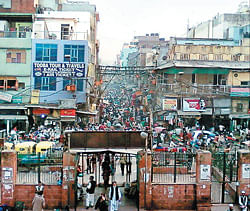Shah Jahan, the fifth Mughal Emperor, is known for his marvellous creation, the Taj Mahal.

He reigned in Agra for 11 years, but after that he made up his mind to shift his capital from Agra to Delhi. You might wonder why he took this decision. It could be due to many reasons. Some historians feel that it was because he found the streets of Agra too narrow and congested for his grand state processions. And also because he found the climate of Agra too humid and oppressive for his liking. Or it could have been because he wanted to escape from the memories of his beloved Mumtaz Mahal.
But the most important reason may have been because the artist and builder in him craved to create more. Percival Spear writes in his History of India, Volume ll: “Shah Jahan was a man of great executive ability to which he added a love for the magnificent and a refined artistic sense, specially for architecture. He was, in a special sense, the architectural director of his day”.
Shahjahanabad, the new capital which took nine years to complete, was occupied by the royal family in 1648. Jahanara and Roshanara, the two princesses, laid out gardens, market squares and serais (rest houses) which were among the most beautiful creations within the new walled city. It was Jahanara, Shah Jahan’s favourite daughter on whom he had conferred the title of Begum Sahib, who had laid out Chandni Chowk, the main market square, and the garden known as Begum ka Bagh.
We find descriptions of Begum ka Bagh in many history books and in the accounts of travellers who saw it then. All of them agree that it was indeed a thing of beauty. Enclosed within a high stone wall on all sides, it had pools and channels for running water. There were fountains and canopies supported on 12 pillars of red stone (called bara dari). These provided cool resting places for the people who came to the garden. The water in the channels came from a special canal system and helped irrigate the trees and grass and plants within. There were plenty of flowering trees and fruit trees.
Some of them were set up with swings. It was the favourite resting place of the princesses and the ladies of the palace. It was also visited by the wives and daughters of the nobles.
Many festivals were celebrated within the Begum ka Bagh. The most important among them was called Pankhon ka mela. It was a fair meant exclusively for ladies and was celebrated for a whole week. There were stalls for lovely embroidered kurtas and dupattas, colourful bangles and other jewellery, toys and all kinds of goodies to eat, gleaming utensils and sparkling crockery, paintings, clay figures and every kind of beautiful objects that you can think of. There were songs, poetry readings, other festivities and games as well. Everyone had a wonderful time.
There is an interesting story about Begum ka Bagh, where only ladies and children were allowed to enter. There was a Persian poet in the court of Shah Jahan, who was very curious about the place and wanted to see it. He was equally keen to catch a glimpse of the princess who had set out this garden and the beautiful Chandni Chowk. The poet wore a burkha over his clothes and sneaked into the garden one day. He saw the royal ladies laughing and joking with each other. Some were on the swings.
The poet was dazzled by Jahanara’s beauty and dignity. He composed a poem about her on the spot. He was just writing it down when Princess Jahanara caught sight of him. She walked up to the poet and asked him what he was doing. While she threatened to punish him, he pleaded with her to hear his poem first. As he recited his poetry, Jahanara and the other ladies in the garden were enchanted by his words. With a little encouragement from the ladies to present the poet with an award instead of punishment, Jahanara handed him a purse filled with coins, and added: “Please don’t stay here another moment. Run as fast as you can! You should never have come here, you know.”
The poet saluted her and left the garden immediately. But once Emperor Shah Jahan got word of the incident, he banished the poet from his kingdom forever.
Begum ka Bagh, like many other monuments, has a history of its own. It remained a garden for the royal ladies until the reign of Shah Alam II. When Begum Samro came to his aid during his battle with the Rohillas, he gave her a piece of land within this garden. Begum Samro built her palace here which was known as Begum Samro’s Palace. The garden came to be called Company Bagh during the early British regime and was thrown open to public.
The name was changed once again to Queen’s Garden in 1857 after Queen Victoria was proclaimed the Empress of India. Then, after many changes, Begum Samro’s Palace got the name of Bhagirath Palace. It is now one of the main markets for electrical goods in Delhi. There is no trace of the beautiful garden any more. What remains of it is known as Gandhi Park.